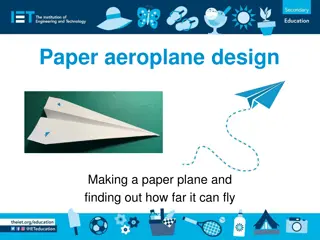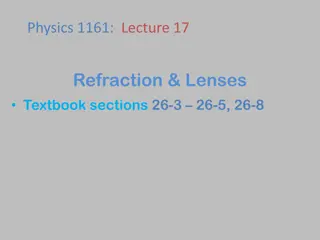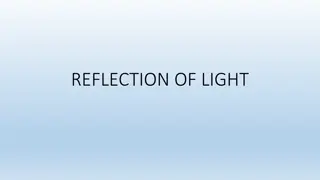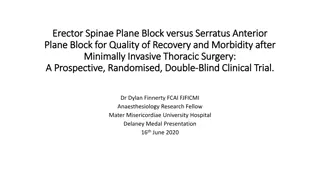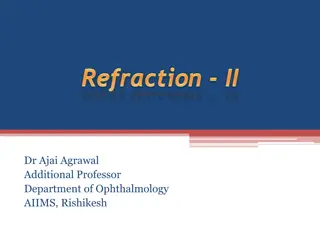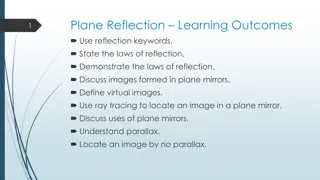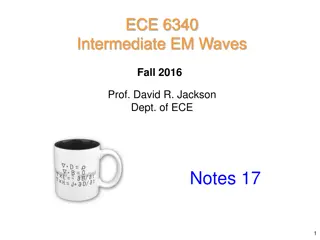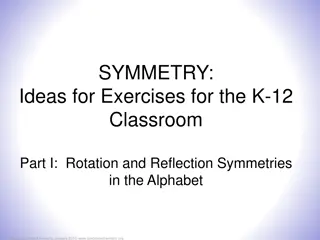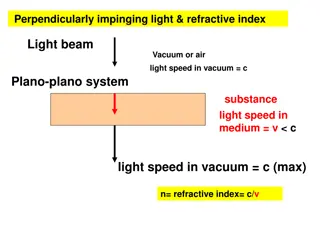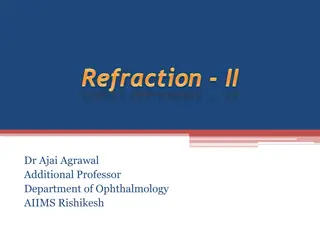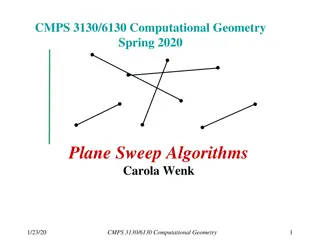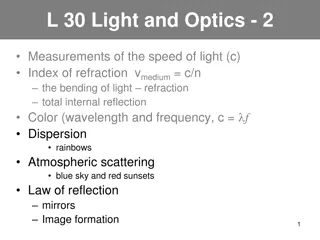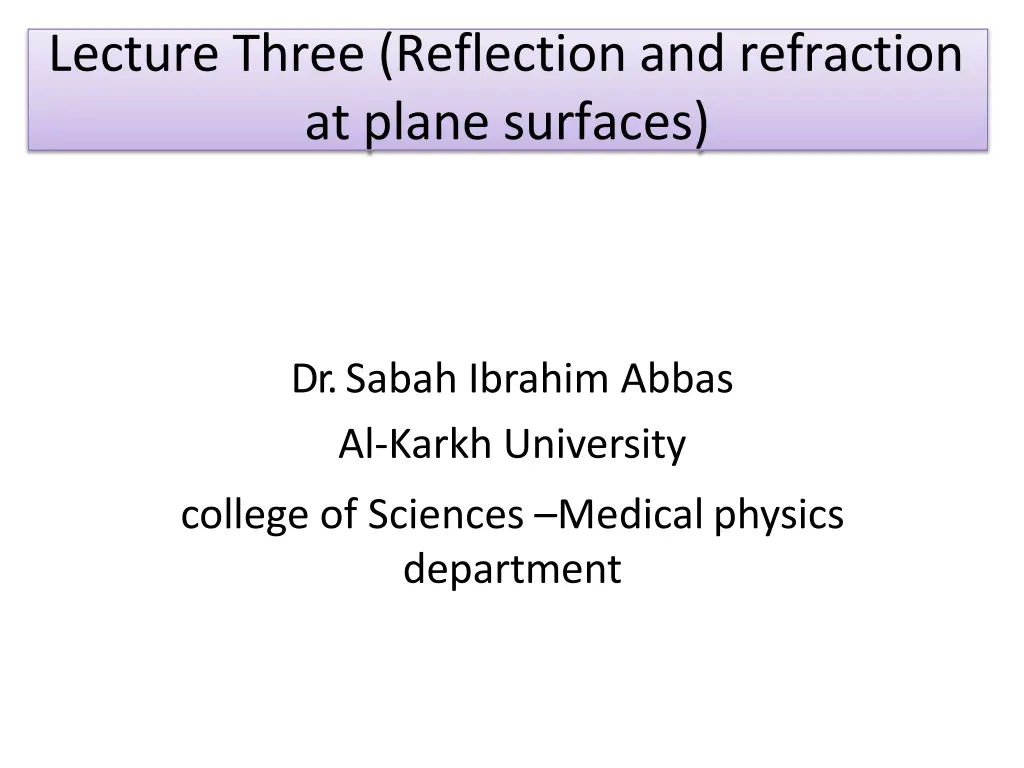
Understanding Reflection and Refraction at Plane Surfaces
Explore the principles of reflection and refraction at plane surfaces with a focus on light rays, angles of incidence and reflection, Snell's Law, and the formation of images by plane mirrors. Geometric optics and ray optics concepts are simplified to explain how light behaves in different media. Dive into the basics of optics and learn how to apply these principles to everyday light phenomena.
Download Presentation

Please find below an Image/Link to download the presentation.
The content on the website is provided AS IS for your information and personal use only. It may not be sold, licensed, or shared on other websites without obtaining consent from the author. If you encounter any issues during the download, it is possible that the publisher has removed the file from their server.
You are allowed to download the files provided on this website for personal or commercial use, subject to the condition that they are used lawfully. All files are the property of their respective owners.
The content on the website is provided AS IS for your information and personal use only. It may not be sold, licensed, or shared on other websites without obtaining consent from the author.
E N D
Presentation Transcript
Lecture Three (Reflection and refraction at plane surfaces) Dr. Sabah Ibrahim Abbas Al-Karkh University college of Sciences Medicalphysics department
Lecture Three (Reflection and refraction at plane surfaces) A light ray is a line (straight or curved) that is perpendicular to the light's wavefronts; Light rays in homogeneous media are straight. They bend at the interface between two dissimilar media and may be curved in a medium in which the refractive index changes. Geometric optics propagate through an optical system. Objects to be imaged are treated as collections of independent point sources, each producing spherical wavefronts and corresponding outward rays. Rays from each object point can be mathematically propagated to locate the corresponding point on the image. describes how rays
Lecture Three (Reflection and refraction at plane surfaces) Ray optics or geometrical optics is the simplest theory for doing optics. In this theory, propagation of light in various optical media can be described by simple geometrical rules. Ray optics is based on a very rough approximation ( 0 , no wave phenomena), but we can explain almost all daily life experiences involving light (shadows, mirrors, etc.). In particular, we can describe optical imaging with ray optics approach. In isotropic media, the direction of rayscorresponds to the direction of energy flow
Lecture Three (Reflection and refraction at plane surfaces) An incident ray is a ray of light that strikes a surface. The angle between this ray and the perpendicular or normal to the surface is the angle of incidence. The reflected ray corresponding to a given incident ray, is the ray that represents the light reflected by the surface. The angle between the surface normal and the reflected ray is known as the angle of reflection. The Law of Reflection says that for a specular (non-scattering) surface, the angle of reflection always equals the angle of incidence. The refracted ray or transmitted ray corresponding to a given incident ray represents the light that is transmitted through the surface. The angle between this ray and the normal is known as the angle of refraction, and it is given by Snell's Law. Conservation of energy requires that the power in the incident ray must equal the sum of the power in the refracted ray, the power in the reflected ray,and any power absorbed atthe surface.
Lecture Three (Reflection and refraction at plane surfaces) Formation of Image by the plane mirror: The formation of image of a point object O by a plane mirror is represented in figure below. The image formed I has the following characteristics.
Lecture Three (Reflection and refraction at plane surfaces) Image formed by plane surface y s ?=? ?= y =1 y
Lecture Three (Reflection and refraction at plane surfaces) Refraction:- When a ray of light falls on the boundary separating the two media, there is a change in direction of ray. This phenomenon is calledrefraction. Laws of Refraction: (1)The incident ray, the refracted ray and normal to the surface separating the two media all lie in the sameplane. (2) Snell s Law: For two media, the ratio of sine of angle of incidence to the sine of the angle of refraction is constant for a beam of particular wavelength ????? ? ??? ?? ?2 sin ?1 ?1 = sin ?2= constant
Lecture Three (Reflection and refraction at plane surfaces) The refractive index of a medium is defined as the ratio of speed of light in vacuum to the speed of light in medium. ??? ? ? ???? ? ? ? ? ? =?= = ?? ? v ? ??? ? ? ? sin ?2 sin ?1 v v1 v1 ? v2 1 2 2 = = = = ?2 ? ??????? ???????Being wavelength of light in air and medium respectively. 1
Lecture Three (Reflection and refraction at plane surfaces) Formation of image by Refraction:- According to Snell s law if ?2> ?1. That is if a ray of light enters from rarer medium to a denser medium, it is deviated towards the normal and if ?2< ?1that is if the ray of light enters from denser to a rarer medium it is deviated away from the normal. Accordingly if the ray of light starting from objects O in denser medium travels along OP, it is deviated away from the normal along PQ. The ray PQ appears to come from I . Thus I is the virtual image of O . It can be shown that:
Lecture Three (Reflection and refraction at plane surfaces) 2? =? ? ? ? ? ? ? ? ( ? ? ) ? ? ? ? ? ? ? ? ? ? ? ? ( ? ? ) ? ? =?


